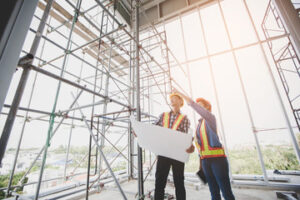Plumbers Bradenton work with a variety of tools and systems. They also must be able to interpret building codes and regulations. They often work directly with clients and must have excellent customer service skills.

They install and repair pipes, fixtures, and equipment for water distribution and waste removal in residential and commercial buildings. They collaborate with architects, builders, and construction teams to ensure that the plumbing is integrated into the overall building design.
Plumbing systems are crucial for homes and businesses, taking waste water away and delivering clean water and energy. They also regulate indoor climate. However, plumbing systems can experience problems like clogs and leaks. Plumbers are responsible for installing and repairing these systems, ensuring that they function efficiently and safely. They also ensure that all work meets state and local regulations. Plumbers use a variety of tools and techniques to perform their job. They must be able to think critically and solve problems systematically. They also need to have excellent customer service skills, as they often interact with clients directly.
Plumbers install new plumbing systems, including piping, fixtures, and appliances such as sinks, toilets, and bathtubs. They follow blueprints and building codes to ensure that the system is installed properly. They may also repair existing pipes and fixtures. They are also responsible for identifying potential issues with the plumbing system and determining the best solution.
Replacing a faucet can be a simple DIY project for homeowners, but it requires the right set of tools. First, shut off the water supply valves underneath the sink. This can be done by turning the valves clockwise. You should also close the drain valves to relieve pressure on the lines. Then, remove the old faucet and install the new one. To prevent leaking, make sure the spout and spout cap are tightly sealed with plumber’s putty or silicone sealant.
If you are installing a new kitchen sink, you should make sure the faucet is the correct size for the hole in your sink. It should also be compatible with the hot and cold water supply valves underneath the sink. Some faucets come with flexible tubes for the hot and cold supply lines, but if yours doesn’t, you will need to connect them yourself. Then, screw the tubes to the corresponding valves under the sink.
Plumbers must be able to work well under pressure and in tight spaces. They also need to have good manual dexterity, as they must be able to manipulate small parts and tools. They also need to have good physical strength and stamina, as they spend long periods of time on their feet. They may also need to lift heavy equipment and tools.
Repairing a leaky faucet
A leaking faucet is an annoying problem that can waste water and money. It can also damage your sink or plumbing fixtures if ignored for too long. But the good news is that a dripping faucet can be fixed by yourself, with some basic tools and replacement parts. In fact, most dripping faucets can be repaired in less than an hour. Here are some tips to help you get started.
The first step is to shut off the water supply lines. This can be done by turning the valves under the sink or at the main water fixture. Once the water is off, you can start to disassemble the faucet. Start by removing the decorative caps and unscrewing the handle. Next, remove the nut and the stem. Be careful not to overtighten the nut, as this can cause it to leak later on. Now you can replace the washer and O-ring, which should be an exact fit for your faucet model. Once the new parts are in place, reassemble your faucet and turn on the water.
Leaking faucets can be caused by a variety of factors, including worn out washers and O-rings, faulty or torn cartridges, cracked valve seats, and frozen supply line hoses. Many homeowners can fix these problems themselves, but it’s always a good idea to call a plumber if you’re not comfortable doing it yourself.
In addition to repairing leaky faucets, plumbers can also install new ones. They can even change the style or type of faucet if needed. They can also handle other plumbing issues, such as clogged drains and water heater repairs. Plumbers must have a strong work ethic and be able to solve complex problems. They often work on evenings and weekends, and may be called to respond to emergency plumbing situations.
Plumbers must be able to think quickly on their feet and have excellent manual dexterity to work with small parts and tools. They must also have the ability to work in tight spaces and be able to stand for long periods of time. In addition, they need to be able to communicate effectively with clients and other professionals.
Replacing a valve
A valve is a part of a plumbing system that controls water flow. These are typically made of metal or plastic and can be found in a variety of shapes and sizes. They are mainly used in pipes to regulate the flow of water and prevent backflow. A leaky valve can result in a significant amount of water loss. A plumber will inspect the location of the leak, determine its cause, and recommend the best solution.
In order to replace a valve, the plumber will first need to shut off the water supply. Then, they will drain the affected area to prevent flooding while working. Once the water is drained, the plumber can begin to remove the old valve and install the new one. They will also ensure that the proper water pressure is restored and check for any other problems with the pipes and fixtures connected to the valve.
There are many different types of valves, including gate valves, ball valves, and stopcocks. Each type of valve has its own advantages and disadvantages. For example, gate valves can be difficult to open and close. However, they are a great choice for applications that require high levels of control. Ball valves are a good choice for use with hot water because they can handle higher temperatures. In addition, they are easy to repair and have a long lifespan.
Besides installing and repairing pipes, a plumber may also work on other parts of the plumbing system. For example, they may install and connect gas lines for stoves, ovens, and water heaters. They may also perform gas leak detection and repair. In addition, they often interpret blueprints and building codes to ensure that all plumbing systems comply with local regulations.
Those who want to become plumbers must have a high school diploma or equivalent. They must also undergo an apprenticeship, which combines classroom instruction with paid on-the-job training. This is a great way to learn the skills and experience needed for this career. In addition, some states may require that plumbers pass an exam to become licensed.
Replacing a handle
Plumbers are skilled professionals who are trained in the installation and repair of water systems. They work on a variety of projects, including installing new taps and toilets, fixing leaky pipes, and unclogging drains. They are also required to have a high level of manual dexterity and attention to detail. In addition, they need to be knowledgeable about plumbing codes and regulations. Plumbers can pursue various certifications to improve their skills and increase their earning potential.
Plumber jobs are a highly in-demand profession that offers stability and a steady income. They are available in a wide range of environments, including commercial and industrial settings. Plumbers typically work with a team of other tradespeople, including carpenters and electricians. In these roles, they often collaborate with architects and construction teams to ensure that plumbing systems are properly integrated into building projects.
To become a plumber, you must have a high school diploma or equivalent and complete an apprenticeship with a master plumber. Apprenticeships can last from three to five years, and during that time you will learn the skills of the trade. You will also be required to pass an exam and obtain a license to practice in your area. Licensing requirements vary by location, but most states and cities require at least two years of experience to become licensed.
A plumber’s duties include installing and maintaining plumbing systems in residential and commercial buildings. They must have excellent customer service skills to communicate with clients and understand their needs. They must be able to troubleshoot issues and repair them quickly and efficiently. They also need to be able to work with a variety of tools and equipment, including wrenches, drills, and power drain cleaners.
In addition to installing and repairing plumbing systems, plumbers may also be called on to perform maintenance tasks such as replacing toilet seals or water filters. They may also be responsible for inspecting and testing water pressure levels, locating blockages or leaks, and repairing drain lines and gas services. Some plumbers also install and repair appliances such as toilets, showers, and dishwashers.





